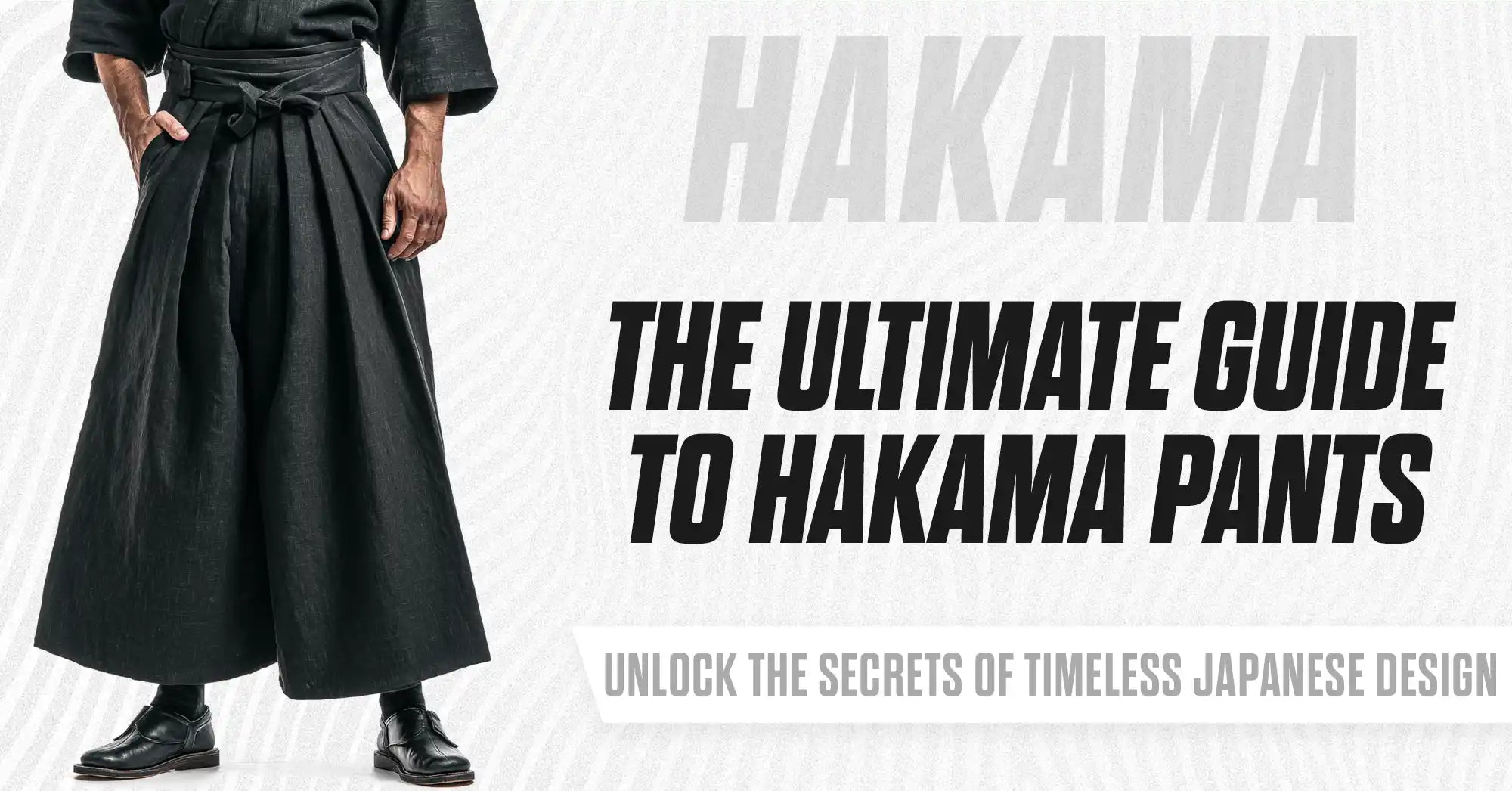
The Ultimate Guide to Hakama Pants
Hakama Pants: History, Styles, How to Wear & Modern Trends
From samurai battlefields to Tokyo streetwear, hakama pants are the ultimate fusion of tradition and contemporary fashion. These iconic pleated trousers have journeyed from 12th-century Japan - where nobility wore them for horseback riding - to becoming a global style statement. Yet most guides fail to capture their true versatility.
Here's what you won't find elsewhere:
-
The complete history of hakama pants (and why they're still worn in martial arts today)
-
Foolproof instructions for tying them properly the first time
-
Modern styling ideas that work for everyday wear
-
Expert tips for choosing the perfect pair
For fashion lovers and culture enthusiasts alike, hakama pants offer:
✔️ Unmatched comfort with their loose, flowing fit
✔️ Timeless elegance that transitions from day to night
✔️ Endless styling possibilities from traditional to contemporary looks
At Techwear Storm™, we've specialized in Japanese-inspired fashion for 4 years. This guide combines our team's expertise with insights from Tokyo's finest textile artisans. You'll get authentic knowledge you can trust, plus recommendations for finding quality hakama pants that last.
The History of Hakama Pants
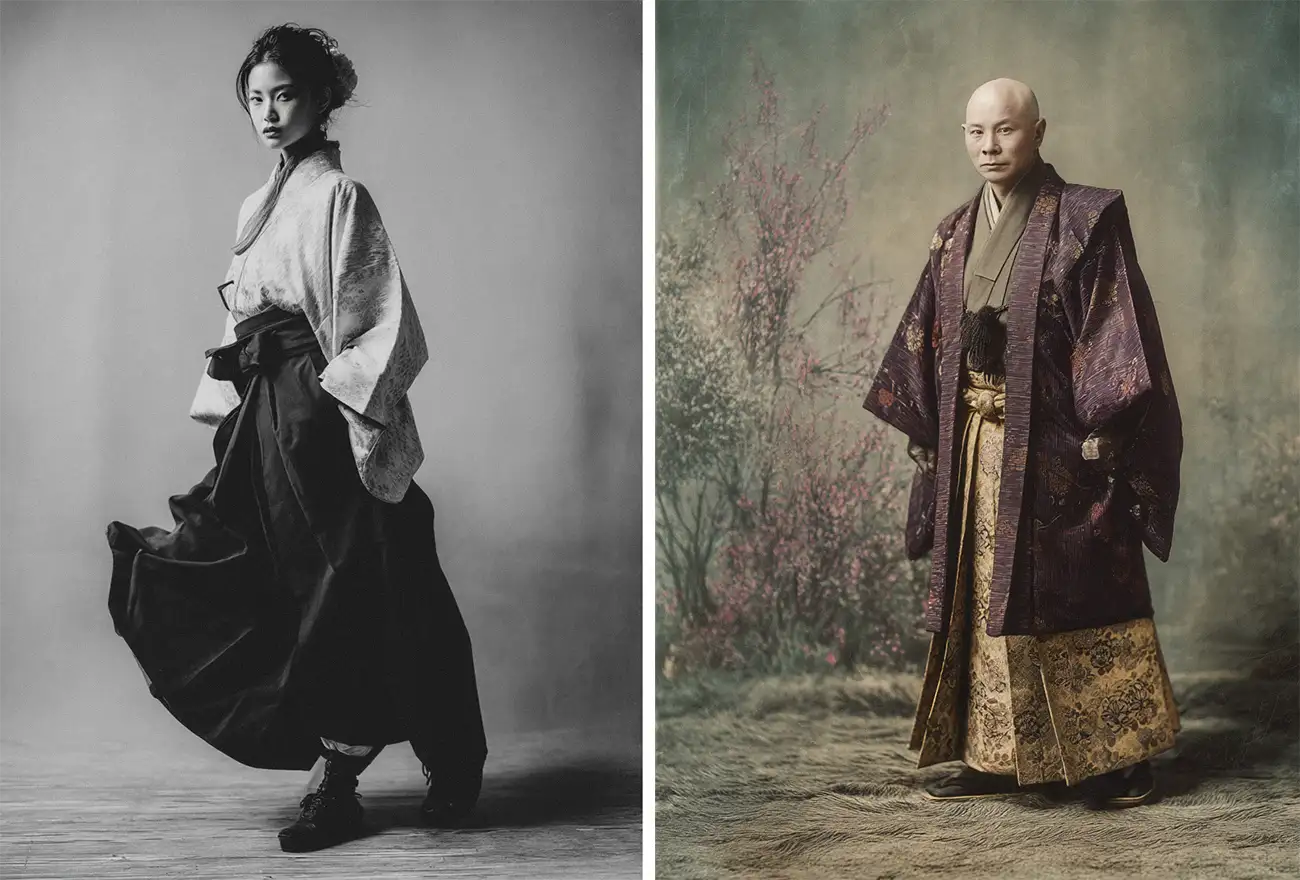
Origins in Feudal Japan
The hakama's story begins in Japan's Heian period (794-1185) , when aristocrats wore these wide-legged trousers to project dignity—their flowing silhouette symbolized status. Crafted from fine silk or hemp, early hakama were so long they dragged on the ground, a deliberate display of wealth (since only the elite could afford to replace fabric ruined by dirt).
By the Kamakura period (1185-1333), samurai adopted hakama for practicality:
-
Horseback Riding: The divided umanori style (馬乗り) allowed freedom of movement in battle.
-
Concealment: Pleats hid leg positioning, giving warriors a tactical edge.
Little-Known Fact: The 7 pleats (5 front, 2 back) represent Confucian virtues like jin (benevolence) and gi (justice)—a detail still honored in modern designs.
Hakama in Martial Arts
When Japan's warrior class faded in the 1860s, hakama found new life in dojos:
Kendo & Aikido:
-
Function: The stiff koshi-ita (back plate) maintains posture during sparring.
-
Color Codes:
-
Black: Worn by high-ranking practitioners (e.g., aikido shihan).
-
Indigo: For students—the dye’s affordability mirrored beginner status.
-
Kyudo (Archery):
Hakama prevent the bowstring from snagging—look for the "hakama himo" (ties) positioned above the hips in antique prints.
Cultural Symbolism Beyond Battle
Tea Ceremonies
Geisha and tea masters wear subdued hakama (often striped) to signify artistry—never white, which is reserved for Shinto priests.
Modern Rebellions
In the 1980s, Tokyo punk bands ripped hakama hems as a protest against tradition—a look echoed in Techwear Storm™’s .
How to Wear Hakama Pants
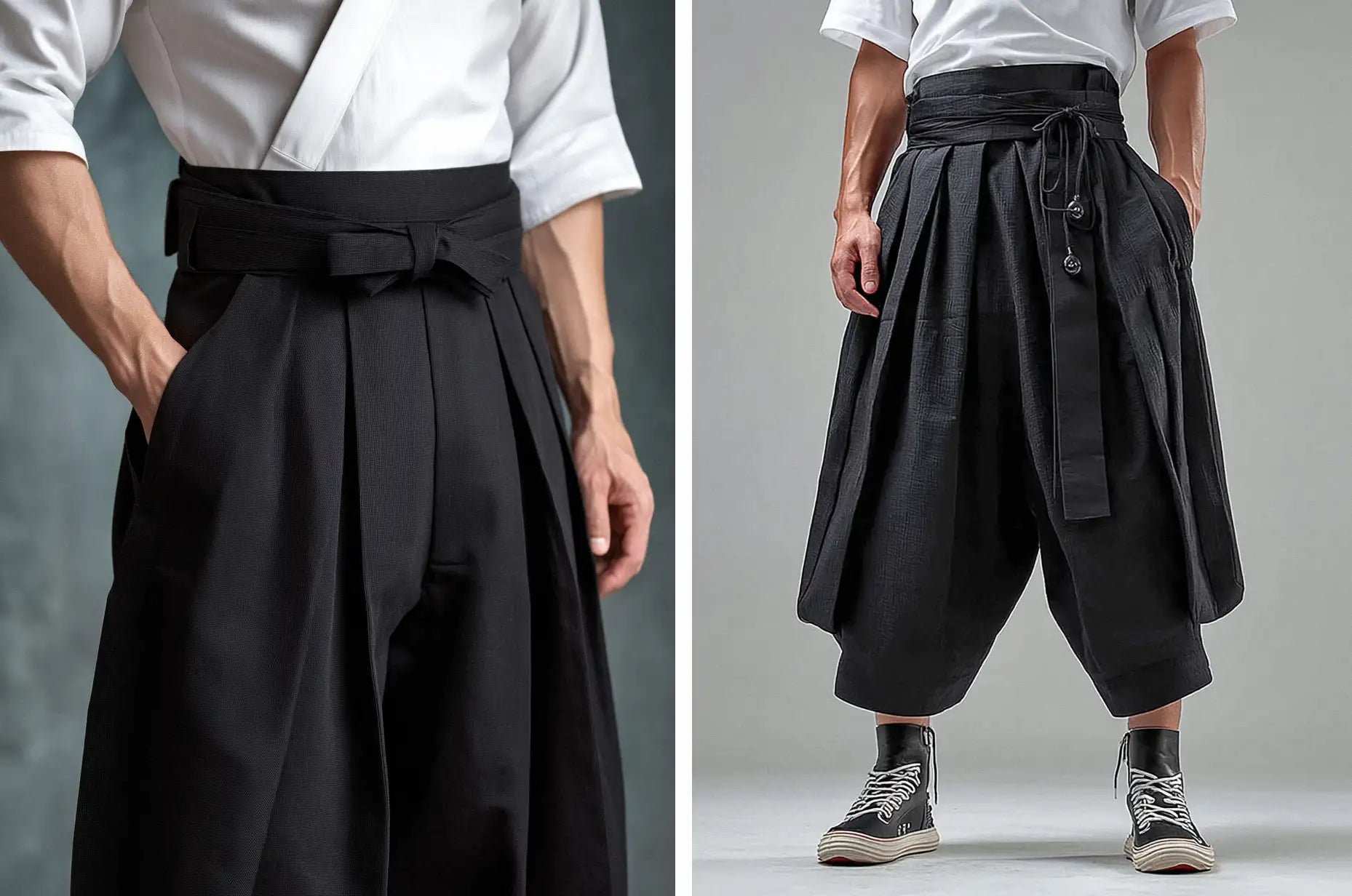
Tying Traditional Hakama
Mastering the art of hakama tying is easier than you think. Follow this foolproof method to achieve the perfect koma-musubi (horse hitch knot), the same technique used by samurai and tea masters.
Step-by-Step Guide
-
Prep Your Hakama
-
Hold the pants by the waistband with the pleats facing outward.
-
Identify the himo (long ties) – the front pair should be slightly shorter than the back.
-
-
Wrap the Waist
-
Position the hakama at your natural waist (higher than modern pants).
-
Cross the back ties in front and bring them around to your back again.
-
-
Tie the Koma-Musubi
-
Cross the right tie over the left to form an "X" at your belly button.
-
Loop the right tie under both layers and pull tight (like tying a shoelace).
-
Adjust the pleats to ensure they hang straight.
-
Modern Styling Tips
Hakama pants are surprisingly versatile – here’s how to style them for contemporary looks:
Streetwear Edge
-
With Sneakers: Pair black hakama with chunky white sneakers and a cropped hoodie.
-
Layering Hack: Wear a longline tank under an unbuttoned shirt for a draped effect.
Elevated Casual
-
Footwear Swap: Try leather loafers instead of zori for a business-casual vibe.
-
Techwear Twist: Add a harness belt over a draped jacket for urban armor aesthetics.
Common Mistakes to Avoid
Fit Fails
-
Too Low: Wearing hakama on hips causes pleats to buckle (always waist-high).
-
Cropped Wrong: Hem should graze the top of your foot – no floods or puddling!
Fabric Faux Pas
-
Stiff Materials: Avoid canvas for everyday wear.
Styling Your Hakama: Beyond the Basics (and Beyond the Traditional)

The true magic of hakama lies in their transformative power – these aren't just pants, but a blank canvas for personal expression. Having styled hakama for everything from Parisian cafés to New York gallery openings, I've discovered their incredible chameleon-like quality . Let me share the advanced techniques that take hakama styling from predictable to extraordinary.
Pairing Hakama with Modern Tops
Minimalist Aesthetics prove hakama don't need elaborate pairings to shine. A perfectly fitted white long-sleeve becomes elevated when the hakama's pleats catch the light with each movement. For winter, try a cashmere turtleneck in muted tones – the contrast between the luxurious knit and structured pleats creates quiet sophistication.
Structured Outerwear redefines hakama proportions. A double-breasted blazer cropped at the waist emphasizes the hakama's volume beautifully. For dramatic evenings, a wool overcoat left unbuttoned allows the hakama to billow dramatically behind you like a modern cape. The key is balancing structure with flow – too stiff and you lose the magic, too loose and the look becomes sloppy.
Layering Techniques separate novices from masters. Start with a slim-fit base layer, add a unbuttoned dress shirt , then finish with a short kimono jacket. Each layer should reveal just a sliver of the one beneath, creating visual depth without bulk. For cooler months, try a sheer mesh top under a chunky knit – the interplay of textures elevates simple hakama to runway-worthy status.
Footwear Choices: Completing Your Hakama Look
The right shoes make or break a hakama outfit. Contemporary sneakers work surprisingly well when they mirror the hakama's volume – think chunky dad sneakers or architectural designs. For edgier looks, combat boots lend grounded weight to airy hakama, especially when the pants are slightly cropped to showcase the footwear.
Traditional zori and geta sandals have modern equivalents worth exploring. Platform sandals with wide straps echo geta's silhouette while being street-ready. For office wear, loafers with elevated soles provide that same lifted effect without looking costumey. The secret lies in the toe shape – slightly rounded, never pointy, to maintain harmony with the hakama's lines.
Accessorizing Hakama: Bags, Hats, and Jewelry
Accessories should complement, not compete with hakama's natural drama. Crossbody bags work best when kept small and positioned high on the torso – this maintains the clean line from shoulder to hem. For headwear, a wide-brimmed fedora adds mystery without overwhelming, while beanies create interesting texture contrast when paired with formal hakama.
Jewelry requires careful curation. A single statement necklace or bold cuff bracelet anchors the look, but avoid delicate pieces that get lost. Men can experiment with obi rings – wide bands worn on the thumb that reference traditional cord ties. The golden rule? Let the hakama remain the star while accessories play subtle supporting roles .
Hakama for Different Occasions
Casual Outfits thrive on contrast. Try a graphic tee with hakama in complementary colors, or a denim shirt left untucked for relaxed vibes. The unexpected pairing of hakama with a sleeveless hoodie creates an intriguing sporty-elegant hybrid perfect for weekend wear.
Semi-Formal occasions call for refined pairings. A turtleneck bodysuit streamlines the silhouette, while a structured waistcoat defines the torso beautifully. For weddings or gallery openings, consider hakama in unexpected neutrals like charcoal or camel paired with textured silks.
Avant-Garde styling breaks all rules tastefully. Drape a transparent hakama over leather pants for dimensional intrigue, or layer multiple hakama in varying lengths. Some daring stylists even incorporate harness details over traditional hakama, creating fascinating tension between restraint and rebellion.
Hakama and Body Types: Finding Your Perfect Fit and Flow
The right hakama silhouette flatters every form. Petite frames benefit from narrower pleats and slightly cropped lengths to avoid overwhelm. Taller wearers can embrace dramatic volume and floor-grazing styles that showcase height.
For curvier figures, hakama with adjustable waist ties provide comfort while the natural drape elegantly skims the body. Those with athletic builds might opt for structured hakama that create the illusion of curves through strategic pleating. The universal truth? Well-fitted hakama make anyone move with unexpected grace – it's all about finding your version of that perfect swing and sway.
Hakama Pants in Fashion
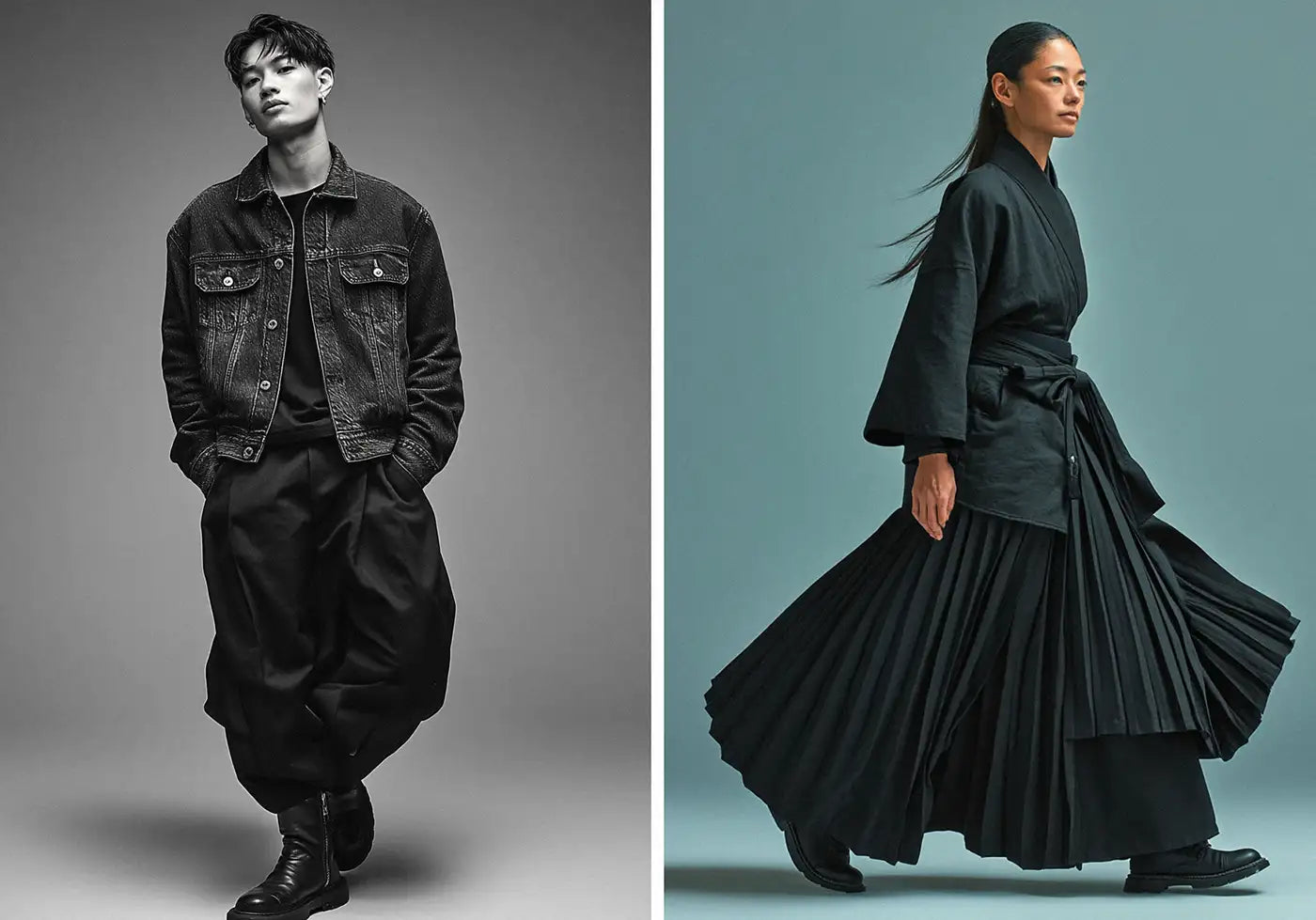
The Runway Revolution - How Designers Are Reinventing Hakama
The fashion world's obsession with hakama pants has reached fever pitch. From Tokyo to Paris, these traditional Japanese garments are being deconstructed and reimagined in ways that honor their heritage while pushing boundaries. Let's examine this sartorial revolution in detail.
Avant-Garde Interpretations
Leading the charge is Yohji Yamamoto, whose signature drapey hakama designs have become runway staples. His 2023 collection featured hakama pants with:
-
Exaggerated 40-inch hems that pooled dramatically around models' feet
-
Asymmetrical pleating that created dynamic movement with each step
-
Hybrid designs combining hakama silhouettes with Western tailoring elements
Other notable designers putting their spin on hakama include:
-
Issey Miyake: Famous for his pleated hakama in tech fabrics that never wrinkle
-
Junya Watanabe: Created hakama-legging hybrids with articulated knee panels
-
Undercover: Punk-inspired hakama with strategic rips and safety pin details
Technical Fabric Innovations
Modern hakama are benefiting from space-age materials:
-
Phase-change membranes that regulate body temperature
-
Self-cleaning nanocoatings that repel stains and odors
-
Shape-memory alloys in waistbands that maintain perfect fit
-
Photochromic dyes that change color in sunlight
Streetwear's Hakama Infiltration
Hakama have become the ultimate flex in urban fashion circles, with distinctive styling approaches emerging:
Hypebeast Approved Looks
-
Sneakerhead Style: Baggy hakama paired with limited-edition Dunks and oversized graphic tees
-
Techwear Fusion: Waterproof hakama with modular attachment points for carabiners and pouches
-
Goth-Ninja: All-black drapey hakama with layered harnesses and combat boots
Regional Street Style Variations
-
Tokyo: Often worn with bulky dad sneakers and cropped puffers
-
London: Paired with tailored blazers and Chelsea boots
-
New York: Street punks layer them under distressed denim jackets
The Future of Hakama Fashion
Smart Textile Integration
-
Biometric monitoring woven into waistbands
-
Self-healing fabrics that repair minor tears
-
LED-embedded pleats for customizable illumination
Sustainable Innovations
-
Algae-based dyes that change hue with pH changes
-
Mycelium leather accents for vegan options
-
3D-knitted zero-waste production methods
The Global Appeal: Hakama Pants in Popular Culture and Subcultures
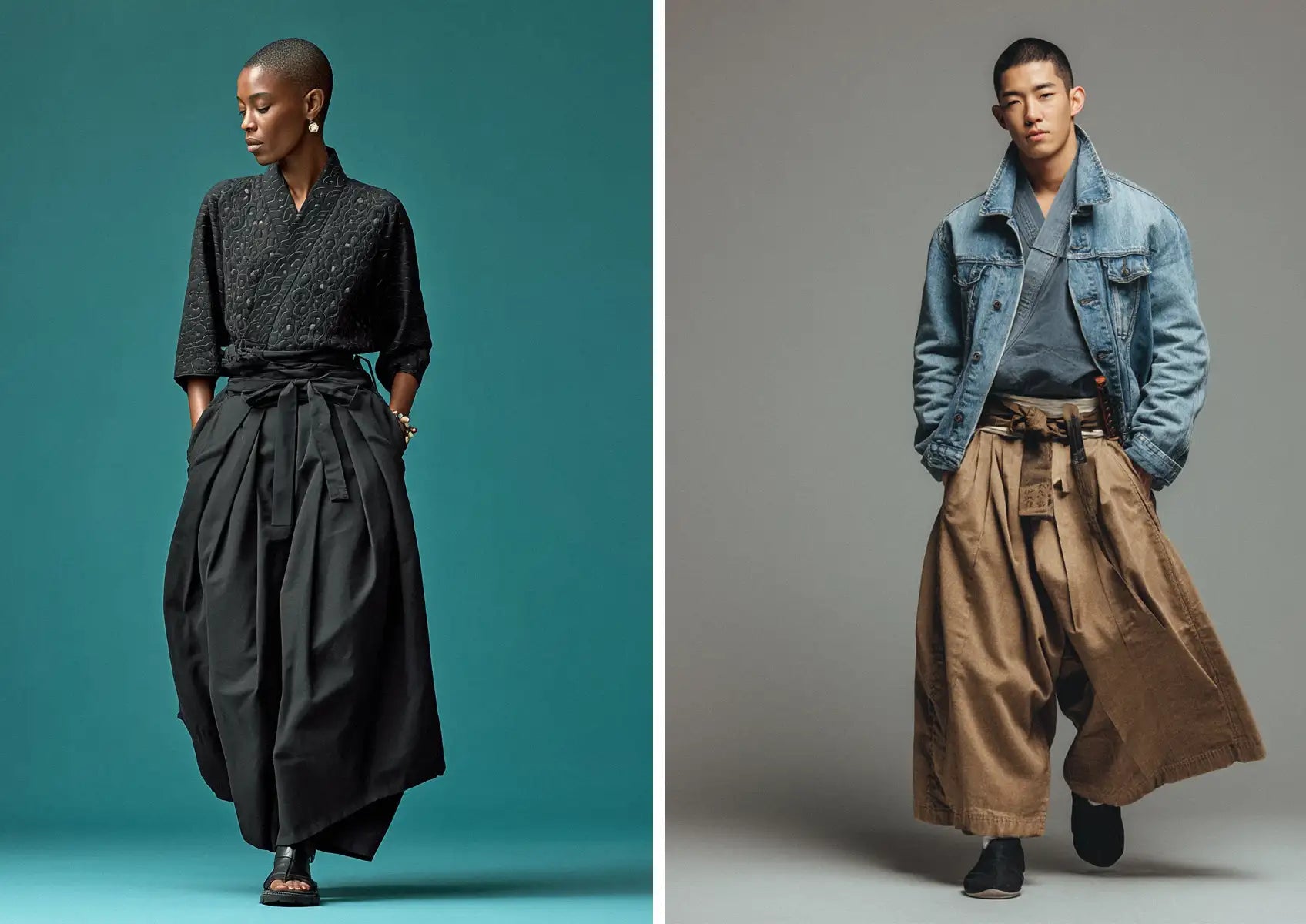
Few traditional garments have achieved the global crossover appeal of hakama pants. What began as functional samurai attire has become a cultural phenomenon appearing everywhere from anime to high fashion runways. Let's explore how hakama transcended their Japanese roots to become international style icons.
Hakama in Anime, Manga, and Video Games
The visual language of hakama makes them perfect for character design. In Demon Slayer, the Water Hashira Giyu Tomioka's mismatched hakama instantly communicates his complex personality - traditional yet unconventional. Game designers leverage this symbolism too:
-
Final Fantasy XIV features multiple hakama styles , from warrior-class battle gear to elegant caster robes
-
Ghost of Tsushima meticulously recreates 13th-century hakama for authenticity
-
Fighting games like Samurai Shodown use flowing hakama to enhance movement animations
Cosplay communities have particularly embraced hakama, with DIY pattern sales increasing 300% after Demon Slayer 's release. The pants' adaptable silhouette works for both historically accurate costumes and gender-bent interpretations .
Contemporary Art and Performance
Modern artists use hakama as living canvases. Performance artist Kimsooja famously wore white hakama during her Needle Woman series, using the garment's volume to create striking silhouettes against urban landscapes.
In dance:
-
Butoh performers bleach hakama to ghostly whiteness
-
Contemporary ballet companies pair hakama with pointe shoes for East-West fusion
-
K-pop idols incorporate hakama-inspired designs in concert costumes , often with high-tech fabrics
The M+ Museum in Hong Kong recently featured hakama in their Japanese Design Today exhibit, highlighting their evolution from functional garment to art object.
Influencer Culture and Hakama
Fashion influencers have democratized hakama styling:
-
@TokyoFashionDiary mixes vintage hakama with vintage band tees
-
@SamuraiStylist teaches followers historical tying methods
-
@SustainableWardrobe advocates for upcycled hakama
The #HakamaStyle hashtag has garnered over 500k posts on Instagram, with particularly strong engagement in:
-
Mexico City's avant-garde scene
-
Berlin's gender-fluid fashion community
-
Seoul's traditional-modern fusion stylists
Hakama in Streetwear
Urban fashion has reinterpreted hakama while respecting their origins:
Silhouette Innovations
-
Cropped hakama with chunky sneakers
-
Overdyed versions in streetwear colors
-
Cargo hakama with added pockets
Cultural Cross-Pollination
-
Harlem designers pair hakama with airbrushed hoodies
-
London streetwear brands use hakama-pleated joggers
-
Parisian skaters wear reinforced hakama for durability
The beauty of hakama's global journey lies in this balance - they maintain cultural significance while adapting to new contexts. Whether in a video game, on stage, or through an influencer's lens, hakama continue to tell powerful visual stories.
Buying Guide
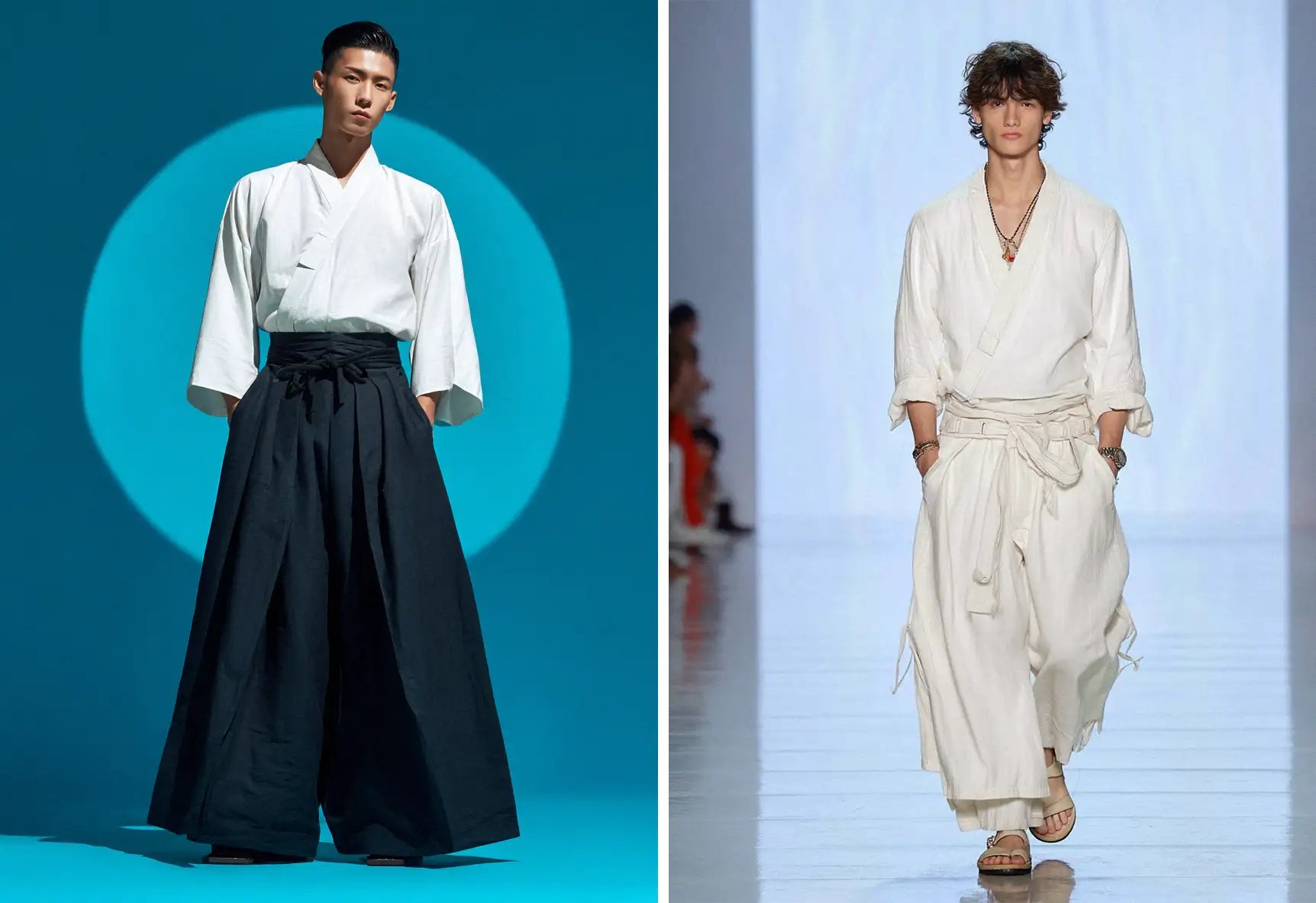
Material Breakdown
Choosing the right fabric is crucial for both authenticity and comfort. Here's what you need to know:
Traditional Cotton Hakama
-
Best for: Purists, martial arts practice, tea ceremonies
-
Pros: Breathable, develops beautiful drape over time
-
Cons: Requires ironing to maintain sharp pleats
-
Care: Hand wash cold, hang dry, starch for formal occasions
Linen & Hemp Blends
-
Best for: Summer wear, historical reenactors
-
Pros: Ultra-breathable, natural wrinkle aesthetic
-
Cons: Stiffer hand feel, prone to shrinkage
-
Pro Tip: Look for pre-washed options to minimize shrinkage
Modern Performance Fabrics
-
Technical Twills: 4-way stretch with pleat memory
-
Water-Resistant Weaves: Ideal for urban commuting
-
Thermoregulating: Phase-change microcapsules for all-season wear
Sizing Demystified
Hakama sizing differs radically from Western pants. Follow this foolproof system:
1. Waist Measurement
-
Traditional hakama sit at the natural waist (2" above navel)
-
Modern styles may offer hip-level fits
-
Key Tip: Size up if between measurements - the himo ties allow adjustment
2. Length Calculation
-
Traditional method: Height × 0.6 = ideal length
-
Streetwear hack: Ankle-grazing for sneakers, floor-length for formal
3. Pleat Proportion
-
Petite frames: Narrower pleats (under 2") prevent overwhelm
-
Tall wearers: Wider pleats maintain visual balance
Hakama Outfit Ideas: From Temple Grounds to City Streets
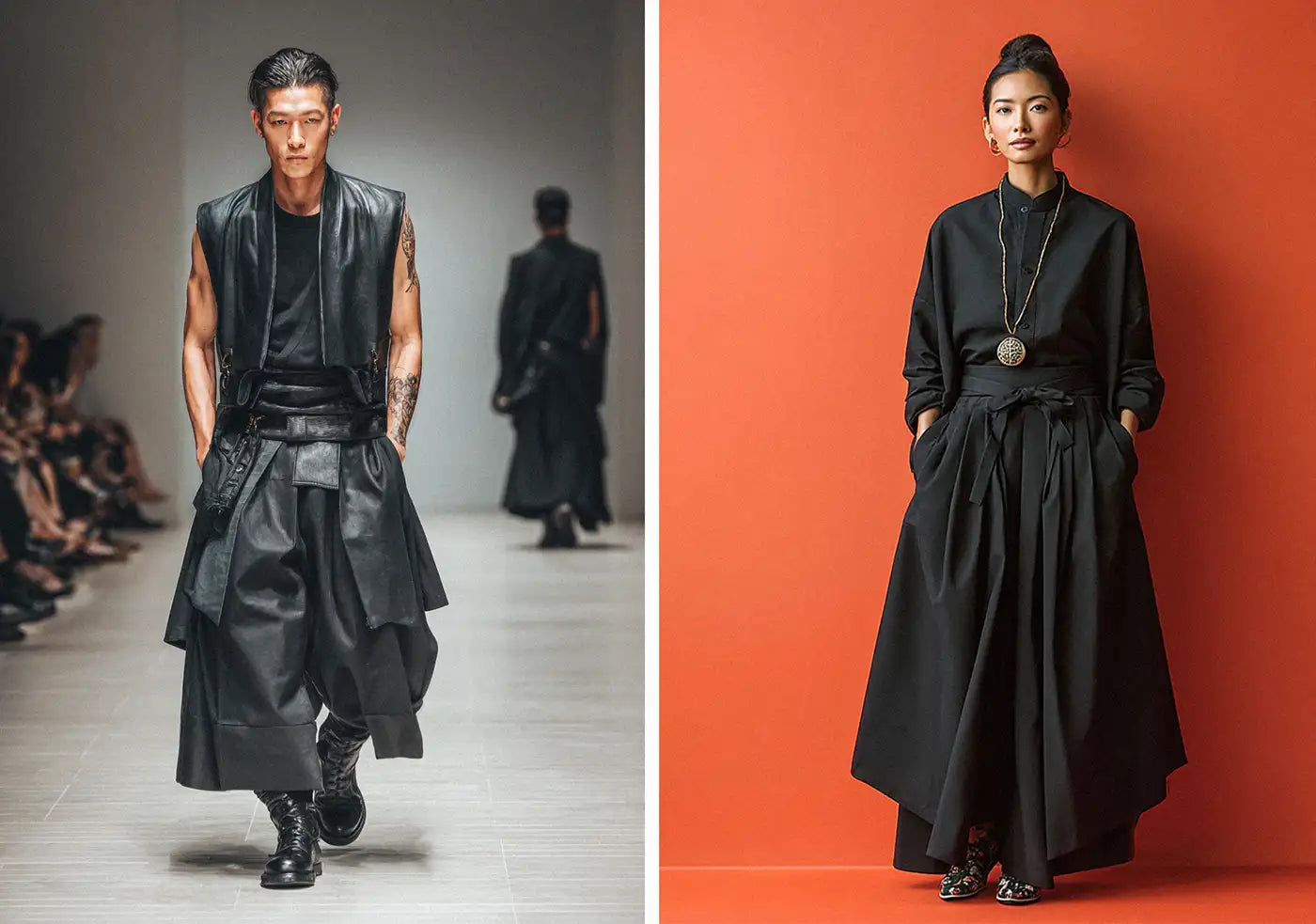
There's an art to wearing hakama pants that transcends time periods and fashion trends. Having styled these iconic garments everywhere from Kyoto tea houses to New York fashion week, I've discovered their remarkable versatility. Let me share the insights that only come from years of trial, error, and occasional wardrobe malfunctions.
The Timeless Formal Ensemble
Nothing compares to seeing hakama in their traditional context . I'll never forget watching a master calligrapher at work, his black silk hakama moving like ink across paper with each deliberate stroke. To achieve this level of authenticity:
Fabric selection makes all the difference
The heaviest silk hakama (12-ounce minimum) create those legendary knife-edge pleats , while modern wool blends offer structure without the stiffness. For contemporary formal wear, seek out hakama with weighted hems - that extra ounce of fabric at the bottom ensures perfect draping whether you're standing in ceremony or sitting through a six-course kaiseki meal.
Modern interpretations that honor tradition
While the classic kimono pairing remains unbeatable, I've had great success with:
-
Structured tuxedo jackets that play with proportion
-
High-neck bodysuits that streamline the silhouette
-
Cropped blazers that reveal just a sliver of midriff
The key lies in balancing traditional elements with contemporary touches. A client recently paired midnight blue hakama with a crisp white shirt and patent leather oxfords for a wedding - the look was simultaneously ancient and avant-garde.
Everyday Wear That Turns Heads
My personal hakama awakening came on a crowded Tokyo sidewalk. A young designer had paired wide-leg hakama with a graphic tee and chunky sneakers - the combination shouldn't have worked, yet it absolutely did. Here's how to make hakama work in casual contexts:
Mastering the art of contrast
The magic happens when you play with proportions. Voluminous hakama demand fitted tops - think muscle tees or slim turtlenecks. Footwear choices make or break the look; I've found platform boots add just the right amount of edge without overwhelming the silhouette.
Weather-adaptive considerations
During a particularly rainy Paris fashion week, I discovered the joy of hakama styling with transparent rain ponchos. The way the fabric draped over the pleats created mesmerizing movement. For summer, nothing beats linen hakama with the barest minimum underneath - though I learned the hard way to choose opaque fabrics for this look.
Professional Settings Reimagined
When a major tech CEO asked me to create a boardroom-appropriate hakama look last year, it challenged everything I knew about traditional Japanese dress. The solution?
We developed a three-piece system:
-
Tailored vest matching the hakama fabric
-
Crisp button-down with French cuffs
-
Loafers with just a hint of shine
The result maintained professionalism while making a bold sartorial statement. For more conservative workplaces, I recommend ankle-length hakama in pinstripe wool - the subtle pattern reads as trousers from a distance while maintaining the distinctive pleated look up close.
Seasonal Adaptations
Each season brings new possibilities. Spring calls for pastel hakama paired with denim jackets - the contrast of structured indigo against flowing peach creates visual poetry. Winter demands creative layering; my favorite combination involves thermal base layers beneath cashmere hakama, topped with a faux fur haori for dramatic effect.
Summer presents the most interesting challenges. After an unfortunate incident involving sheer hakama and strong winds, I now recommend testing all warm-weather outfits at home first. Woven straw accessories and barefoot styling can work beautifully if executed with care.
Final Thoughts From a Hakama Convert
What began as professional curiosity has become a lifelong passion . Hakama pants offer something rare in fashion - a direct connection to history that still feels relevant today. Whether you're attending a formal ceremony or just grabbing coffee, these garments invite you to move through the world with intention and grace.
The most important lesson? Don't be afraid to experiment. Some of my best looks came from happy accidents - like the time I used an antique obi as a scarf, or when I discovered that hakama pockets perfectly fit a modern smartphone. Fashion should be joyful, and nothing sparks joy quite like hakama done right.
FAQs
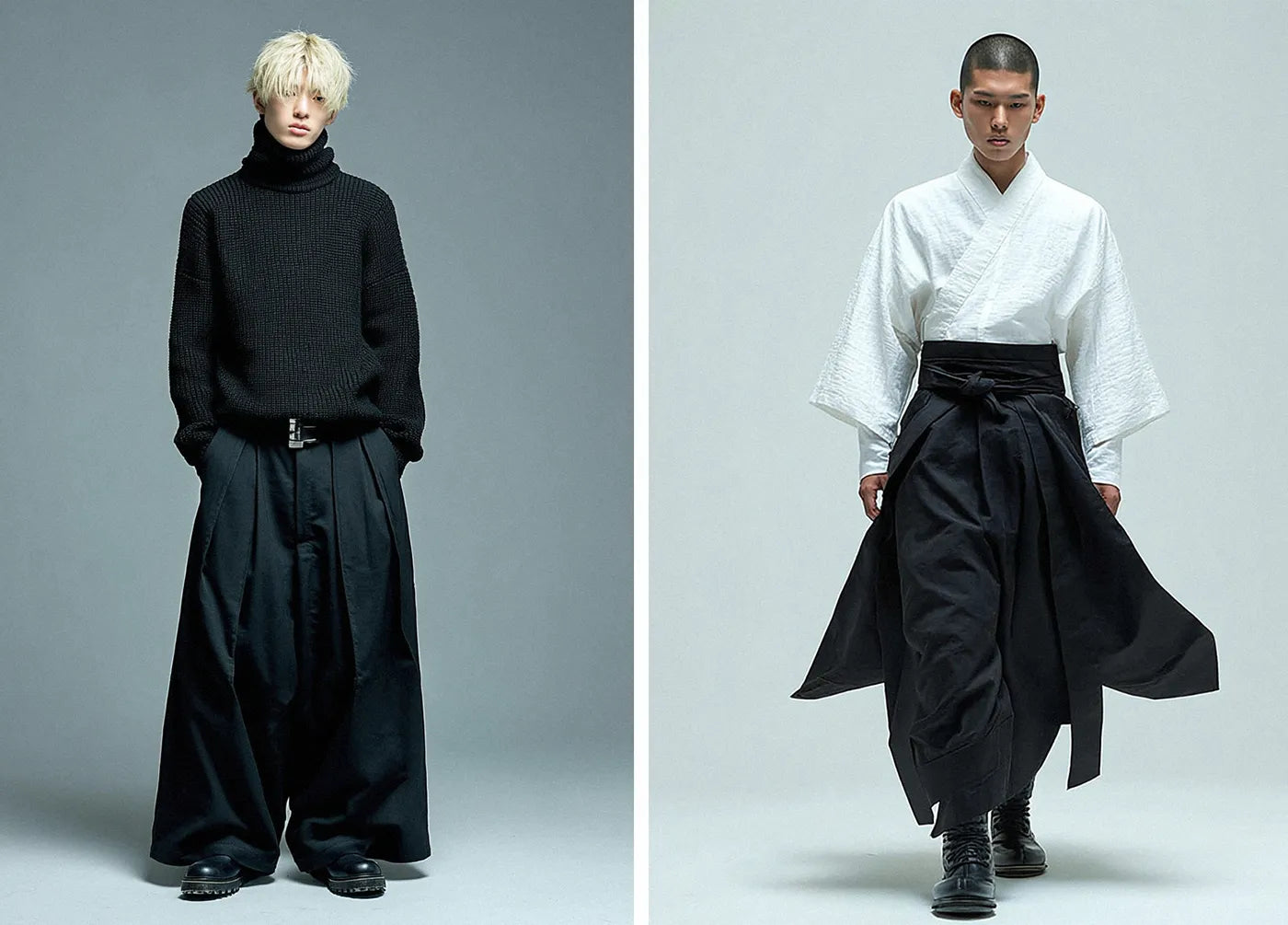
Can Women Wear Hakama Pants?
Absolutely! Hakama pants have been unisex since the Meiji era (1868-1912), when Japan's modernization opened traditional clothing to all genders. In fact:
-
Women students first wore hakama at Tokyo's Ochanomizu University in 1871
-
Modern shrine maidens (miko) pair red hakama with white kosode
-
Contemporary designers like Rei Kawakubo create hakama specifically for female proportions
The only difference? Women traditionally tie the himo (waist cords) in a soft bow at the back rather than the front. But rules are meant to be broken - I've styled women with front-tied hakama for a bold, androgynous look that turns heads.
How to Wash Hakama Pants?
Hand washing is ideal, but here's the full care guide I've developed after ruining (and saving) dozens of hakama:
For Traditional Silk/Wool Hakama
-
Spot clean stains immediately with club soda
-
Use lukewarm water and pH-neutral detergent
-
Never wring - press between towels to absorb moisture
-
Hang dry away from direct sunlight
-
Steam iron while slightly damp to reset pleats
Modern Synthetic Hakama
-
Can usually handle gentle machine cycles
-
Use a mesh laundry bag
-
Remove immediately after washing
-
Tumble dry low with tennis balls to fluff pleats
Nightmare Scenario Fixes:
-
Yellowed silk? Soak in buttermilk for 30 minutes before washing
-
Musty smell? Place in freezer overnight before airing out
-
Crushed pleats? Hang in bathroom during hot shower for steam refresh
Other Common Questions
"Are hakama pants comfortable?"
Once you master the tying technique, yes! The wide, pleated design allows incredible freedom of movement. For beginners, I recommend:
-
Elastic waist hakama for all-day wear
-
Linen blends that soften with use
-
Breaking in new hakama by wearing them at home first
"Can hakama pants be tailored?"
Yes, but with caveats:
-
Length adjustments are easiest (just maintain the original hem)
-
Waist reductions require careful reconstruction of the himo ties
-
Never alter the pleat spacing - it destroys the garment's balance
"How long do hakama pants last?"
With proper care:
| Material | Lifespan | Best For |
|---|---|---|
| Silk | 15-20 years | Formal occasions |
| Wool | 10-15 years | Winter wear |
| Linen | 5-8 years | Casual summer use |
| Polyester | 3-5 years | Daily wear |
Final Care Tips
-
Store hakama folded along original pleat lines
-
Use cedar blocks to prevent moths (never naphthalene!)
-
Rotate between 2-3 pairs to extend each one's lifespan
Remember: Well-maintained hakama develop a beautiful worn-in elegance over time - the slight fading of indigo dye tells your personal story.
Conclusion: Embrace the Legacy of Hakama Pants
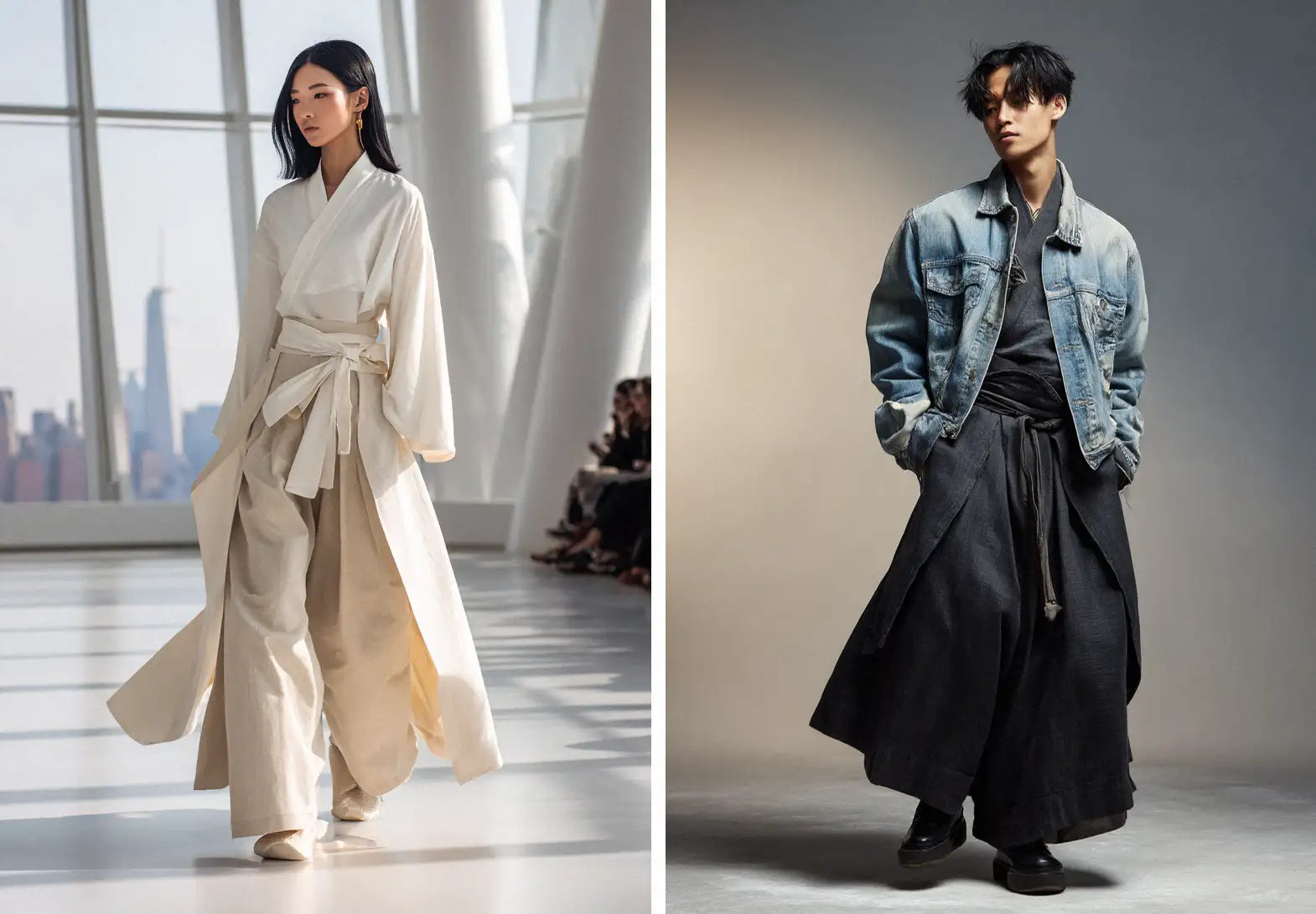
Wearing hakama pants is more than a fashion choice—it's an immersive cultural experience . From their samurai roots to modern streetwear reinventions, these iconic garments carry centuries of Japanese craftsmanship in every pleat.
Why hakama belong in your wardrobe:
-
Their timeless silhouette flatters every body type
-
The versatility bridges formal and casual occasions
-
Each wear connects you to living history
For first-time buyers, start with:
-
A mid-weight cotton pair for daily wear
-
Neutral colors that mix with your existing wardrobe
-
Our Easy-Tie system hakama to skip the learning curve
Still buzzing from hakama inspiration but craving concrete combos? Our battle-tested styling playbook breaks down exactly how to weaponize those pleats for street, office, or apocalypse-ready looks.
Ready to rock hakama pants?
Final Thought: More than pants, hakama are a cultural statement . Whether you honor tradition or reinvent the rules, wearing them becomes a personal dialogue between past and present. How will you write your chapter in hakama history?


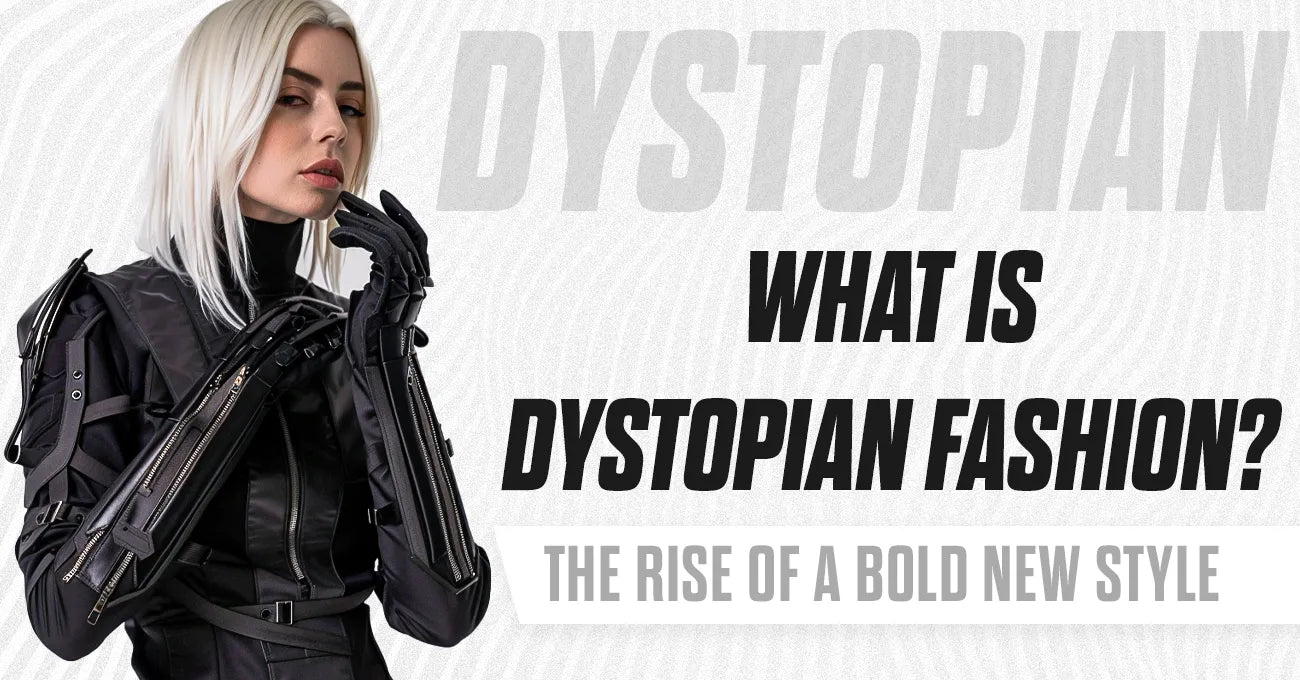

Leave a comment
This site is protected by hCaptcha and the hCaptcha Privacy Policy and Terms of Service apply.